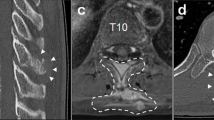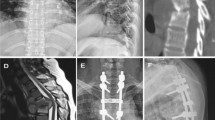Abstract
Introduction
The treatment of thoracic spine fracture–dislocations is now well established with the recent progress in spine surgery. Although most affected individuals have a degree of spinal cord injury (SCI), early surgical reduction, and stabilization of the unstable deformity allow an immediate program of rehabilitation. Vertebrectomy is considered as the last surgical technique reserved for the most persistent spinal deformities that cannot be brought to an acceptable correction with less invasive methods.
Case presentation
We present a case of a 19-year-old male with a sub-acute thoracic spine fracture–dislocation at the level of T7–T8 who underwent a posterior T8 vertebrectomy with reduction and instrumentation from T4 down to T1. The individual had excellent results during follow-ups regarding alignment, fusion, and rehab program.
Discussion
In this case, we present the good outcome of vertebrectomy and spine shortening in an individual with thoracic spine fracture–dislocation, and the advantages of posterior approach.
Similar content being viewed by others

Log in or create a free account to read this content
Gain free access to this article, as well as selected content from this journal and more on nature.com
or
References
Levine AM. Facet fractures and dislocations of the thoracolumbar spine. In: Levine AM, Eismont FJ, Garfin SR, et al. Editors. Spine trauma. Philadelphia: Saunders; 1998. p. 415–427.
Bradford DS, Tribus CB. Vertebral column resection for the treatment of rigid coronal decompensation. Spine. 1997;22:1590–9. 3
MacLennan A. Scoliosis. Br Med J. 1922;2:865–6.
Shimizu K, Ido K, Fujio K, Tanaka K, Nakamura T. Total spondylectomy and spinal shortening for giant-cell tumour of spine. Lancet. 1996;348:342.
Pappou IP, Papadopoulos EC, Swanson AN, et al. Pott disease in the thoracolumbar spine with marked kyphosis and progressive paraplegia necessitating posterior vertebral column resection and anterior reconstruction with a cage. Spine. 2006;31:E123–E127.
Reyes-Sanchez A, Rosales LM, Miramontes VP, et al. Treatment of thoracolumbar burst fractures by vertebral shortening. Eur Spine J. 2002;11:8–12.
Barbera J. T12-L1 telescoped chronic dislocation treated by en bloc one-piece spondylectomy and spine shortening. J Spinal Disord Tech. 2004;17:163–166.
Obeid I, Guérin P, Gille O, et al. Total vertebrectomy and spine shortening in the management of acute thoracic spine fracture dislocation: technical note and report of 3 cases. J Spinal Disord Tech. 2011;24:340–345.
Barcelos A, Botelho R. Treatment of subacute thoracic spine fracture-dislocation by total vertebrectomy and spine shortening. J Neurosurg Spine. 2013;18:194–200.
Zhang S, Yan T-B. Severe fracture-dislocation of the thoracic spine without any neurological deficit. World J Surg Oncol. 2017;15:3.
Denis F. The three column spine and its significance in the classification of acute thoracolumbar spinal injuries. Spine. 1983;8:817–31.
Bohlman HH, Freehafer A, Dejak J. The results of treatment of acute injuries of the upper thoracic spine with paralysis. J Bone Jt Surg Am. 1985;67:360–9.
Rahimi-Movaghar V, Sayyah MK, Akbari H, et al. Epidemiology of traumatic spinal cord injury in developing countries: a systematic review. Neuroepidemiology. 2013;41:65–85.
Aleissa S, Alassiri S, Aljehani RM, et al. Neurological disability among adults following traumatic spinal fractures in Saudi Arabia: a retrospective single-center medical record review. Ann Saudi Med. 2019;39:8–12.
Joaquim AF, Patel AA.Thoracolumbar spine trauma: evaluation and surgical decision making.J Craniovertebr Junction Spine. 2013;4:3–9.
Vaccaro AR, Oner C, Kepler CK, et al. AOSpine Spinal Cord Injury & Trauma Knowledge Forum. AOSpine thoracolumbar spine injury classification system: fracture description, neurological status, and key modifiers. Spine. 2013;38:2028–37.
Vaccaro AR, Zeiller SC, Hulbert RJ, et al. The thoracolumbar injury severity score: a proposed treatment algorithm. J Spinal Disord Tech. 2005;18:209–15.
Joaquim AF, Ghizoni E, Tedeschi H, et al. Clinical results of patients with thoracolumbar spine trauma treated according to the thoracolumbar injury classification system and severity score. J Neurosurg Spine. 2014;20:562–7.
Joaquim AF, Schroeder GD, Patel AA, et al. Clinical and radiological outcome of non-surgical management of thoracic and lumbar spinal fracture-dislocations—a historical analysis in the era of modern spinal surgery. J Spinal Cord Med. 2018;43:3–9.
Zhu Q, Shi F, Cai W, et al. Comparison of anterior versus posterior approach in the treatment of thoracolumbar fractures: a systematic review. Int Surg. 2015;100:1124–33.
Grewal S, Chamarthy MR, Kalva SP. Complications of inferior vena cava filters. Cardiovascular Diagnosis Ther. 2016;6:632–41.
Mathew J, Povlow MR, Fong A. Get off my back! Inferior vena cava filter erosion into the lumbar spine. BMJ Case Rep. 2019;12.
Alabed S, Belci M, Middendorp JJV, et al. Thromboembolism in the sub-acute phase of spinal cord injury: a systematic review of the literature. Asian Spine J. 2016;10:972.
Author information
Authors and Affiliations
Corresponding author
Ethics declarations
Conflict of interest
The authors declare that they have no conflict of interest.
Additional information
Publisher’s note Springer Nature remains neutral with regard to jurisdictional claims in published maps and institutional affiliations.
Rights and permissions
About this article
Cite this article
AlEissa, S.I., Konbaz, F.M., AlMugren, T.S. et al. Management of thoracic spine dislocation by total vertebrectomy and spine shortening: case report. Spinal Cord Ser Cases 6, 80 (2020). https://doi.org/10.1038/s41394-020-00327-9
Received:
Revised:
Accepted:
Published:
DOI: https://doi.org/10.1038/s41394-020-00327-9
This article is cited by
-
Biomechanical comparison of spinal column shortening - a finite element study
BMC Musculoskeletal Disorders (2022)


